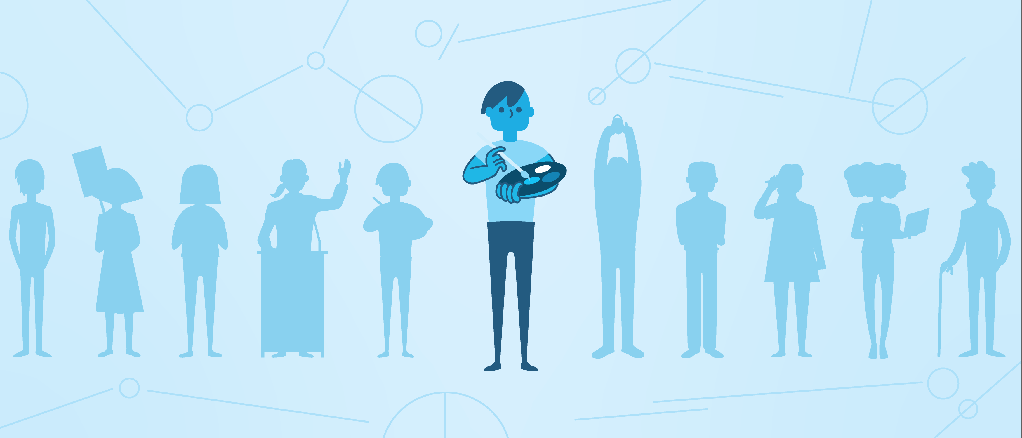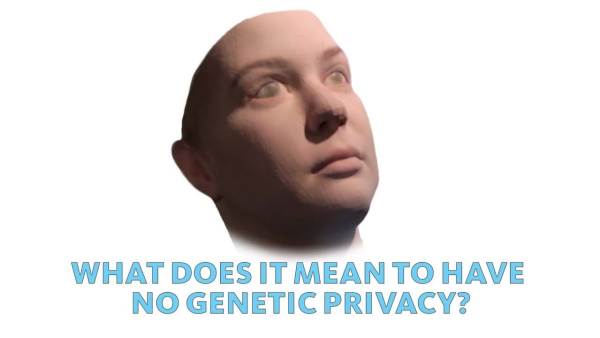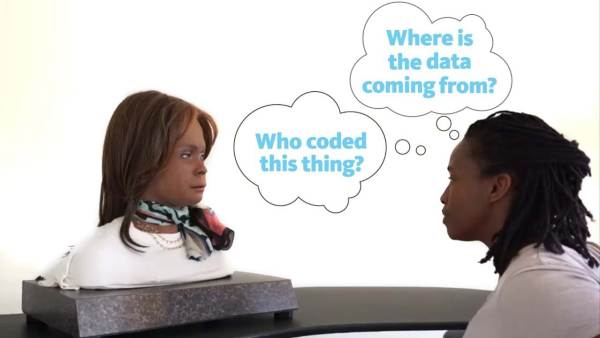Artist

“I identify as an artist, but only because it seems to be the term that allows me the most latitude. I was interested in the technical platforms that were influencing our lives and specifically how we express culture or rituals.”
– Mimi Onuoha, mixed media artist
Artists use a range of mediums to express themselves, their beliefs and ideas. Those who work at the intersection of art and tech—like transdisciplinary artist Stephanie Dinkins and bio-hacker Heather Dewey Hagborg—are using their creativity to serve the greater public good. We also call them public interest technologists.
Public interest tech is about all of us. To thrive, it needs the talent and dedication of people, organizations, and funders.
Transcript
Carmen Aguilar Y Wedge: Hyphen-Labs, take one.
Ece Tankal: Take two.
[Ashley Baccus-Clark, member of Hyphen-Labs, a Black woman with locs wearing a jean jacket.]
Ashley Baccus-Clark: We are an international team of women of color, creating art, cognitive impact research, and different forms of media.
[Ece Tankal, member of Hyphen-Labs, a Turkish woman with long wavy hair, wearing a short sleeve white button down shirt.]
Ece Tankal: We use the pillars of the art, which is an imagination and fantasy, and show people how they can use the technology to start imagining new ways of being.
Ashley Baccus-Clark: When you see virtual reality you don’t really see, you know, stories about women or about women of color, specifically, and it can seem like we don’t belong in that space.
[Carmen Aguilar Y Wedge, member of Hyphen-Labs, a Latinx woman with short curly hair, wearing a white t-shirt with a solid blue box on the front.]
Carmen Aguilar Y Wedge: In using virtual reality, we’re really pulling from our own experience to further a narrative that can also question what our future looks like.
Ashley Baccus-Clark: NeuroSpeculative AfroFeminism—it’s a multiplatform storytelling experience. And one piece of it is virtual reality, where we place our audience inside of the body of a young black avatar and put them into a reimagined hair salon. And there, instead of getting their hair done, they’re getting their brain optimized.
[VR goggles take us into a hair salon in a dark virtual world, a Black woman with short blue hair and a fitted zebra-striped outfit walks by a purple leopard print curtain. Twelve connected vintage hair dryer domes hang from the ceiling like a chandelier, each with mechanical tentacles flowing off the ends.]
Ece Tankal: We’re trying to ignite a spark in people’s minds—there’s not only one way of living.
[A dark neon glowing virtual world. Three VR deities stand upon a columned stage and relay a message.]
Deities: You are free from the constraints that have been placed on you throughout reality. There is no pain or suffering in this world. The only limit is your imagination. This is a blank slate.
Carmen Aguilar Y Wedge: Public interest technology is something that we’re constantly thinking about because it’s our communities and our families that are also being neglected when it comes to how people are thinking about technology.
Ashley Baccus-Clark: We have to encourage more and more people to experiment.
Ece Tankal: It could be a VR. It could be a mobile app. But everybody should be having a say in the creation of the technology.
Ashley Baccus-Clark: We want to see more people who look like us in the room, sitting around the table—and as we do that, bring people up with us.
Carmen Aguilar Y Wedge: I call other people who are not public interest technologists to look into what it would take for them to make that part of who they are.
Ashley Baccus-Clark: The future is ours to create and we all are important and we all have a responsibility to make sure that we are included in this future.
[Returning to the virtual hair salon, a virtual voice gives instructions.]
VR voice: Here are the coordinates to your next modulation session. We’ll see you there!
[This is tech at work for the public! Hashtag Public Interest Tech. Ford Foundation dot org forward slash tech. Ford Foundation logo: a globe made up of a series of small, varied circles.]
Accessibility Statement
- All videos produced by the Ford Foundation since 2020 include captions and downloadable transcripts. For videos where visuals require additional understanding, we offer audio-described versions.
- We are continuing to make videos produced prior to 2020 accessible.
- Videos from third-party sources (those not produced by the Ford Foundation) may not have captions, accessible transcripts, or audio descriptions.
- To improve accessibility beyond our site, we’ve created a free video accessibility WordPress plug-in.
“In using virtual reality, we’re pulling from our own experience to further a narrative that can question what our future looks like.”
– Artist collective Hyphen-Labs
Artist collective Hyphen-Labs, an international team of women of color, created Neurospeculative Afrofeminism—a multi-platform storytelling experience that places audiences inside the body of a young black avatar.

